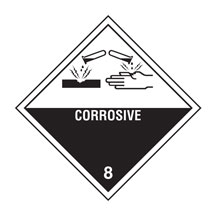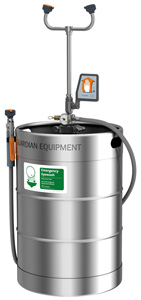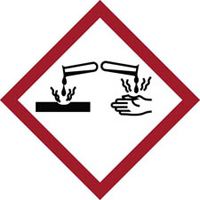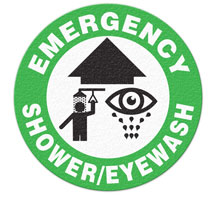



Find all of your laboratory and workplace safety supplies at Safety Emporium!
 Conjunctivitis |
 Glossary Index |
 COSHH |
| MSDS Topics |
Free Sites | FAQ's | Regulations | Glossary | Software | Suppliers |
| Books | Forum | Poll | Fun stuff | Quiz | Store | |
| Understand your MSDS with the MS-Demystifier | Search ALL our MSDS info | |||||

Mark your corrosive containers and shipments with DOT shipping labels and placards from Safety Emporium.
A corrosive material is a highly reactive substance that causes obvious damage to living tissue. Corrosives act either directly, by chemically destroying the part (oxidation), or indirectly by causing inflammation.
Acids and bases are common corrosive materials. Corrosives such as these are also sometimes referred to as caustics.
Typical examples of acidic corrosives are hydrochloric (muriatic) acid and sulfuric acid. Typical examples of basic corrosives are sodium hydroxide and lye.
The OSHA definition of corrosive in 29 CFR 1910.1200 App A is:
"... a chemical that produces destruction of skin tissue, namely, visible necrosis through the epidermis and into the dermis, in at least 1 of 3 tested animals after exposure up to a 4-hour duration. Corrosive reactions are typified by ulcers, bleeding, bloody scabs and, by the end of observation at 14 days, by discoloration due to blanching of the skin, complete areas of alopecia and scars. Histopathology should be considered to discern questionable lesions.
Rust and electrochemical oxidation are forms of corrosion that occur on metals, but a) these typically occur on a much slower time scale and b) these are not a health effect and, therefore, are not usually noted on an SDS except perhaps in storage recommendations. The U.S. Department of Transportation includes metal in their definitions.
Corrosive materials can be in solid, liquid or gas form and pose serious immediate risk to skin, tissues, eyes, lungs, and other parts of the body. Any external body part coming in contact with a corrosive material must be flushed with water IMMEDIATELY and then medical attention or opinion should be sought.
Almost every medical resource, consensus standard, and SDS says that the water flushing should last 15 minutes, however there is some question whether such long flushing periods may offer significant benefit in all cases, particularly when it could unnecessarily delay the course of emergency treatment.

Safety Emporium carries all kinds of eye/face washes, safety showers, drench hoses to provide protection against corrosive substances.
For example, with a particularly dangerous chemicals such as concentrated hydrofluoric acid, rinsing more than 5 minutes would undoubtedly be less effective than administering treatment with calcium gluconate gel. Likewise, if a chemical accident involves traumatic injuries, a shorter rinse period may be necessary in order to stem bleeding etc.
The Canadian Centre for Occupational Health & Safety has indicated that The flushing or rinsing time can be modified if the identity and properties of the chemical are known. For example:
Non-penetrating corrosives are chemicals which react with human tissue to form a protective layer which limits the extent of damage. Most acids are non-penetrating corrosives. Penetrating corrosives, such as most alkalis, hydrofluoric acid and phenol, enter the skin or eyes deeply. Penetrating corrosives require longer water flushing (a minimum of 60 minutes) than non-penetrating corrosives (a minimum of 20 minutes).
Note that while the CCOHS advice is a sensible risk-based approach, we would not recommend that anyone delay treatment of an hydrofluoric acid exposure for 60 minutes! As should be readily apparent by now, the flushing period that gives the best clinical outcome for the victim is going to depend on the nature of the chemical, its concentration, the availability of medical treatment, the available water temperature, the condition of the victim and many other factors. The bottom line is that "15 minutes" is a rule of thumb (or best guess), not an ironclad rule. The actual time necessary in a given situation may be shorter or longer.
Corrosives that are inhaled or ingested (eaten) must be dealt with by medical professionals. DO NOT induce vomiting for ingestion of a corrosive material as additional damage to the esophagus, throat and mouth will occur upon regurgitation. Consult the SDS, an emergency room and/or your poison control center for first aid procedures in the event of ingestion.

The GHS corrosive pictogram. Get your GHS-compliant labels and signs from Safety Emporium.
When the term "corrosive" appears on Section 2 (Hazard(s) identifications) of a Safety Data Sheet, it will generally also appear in multiple other sections regarding storage, spill control, health effects and more. Corrosive materials demand great care, so read the SDS in carefully and completely to ensure you are fully informed on about the hazard as well as how to reduce your risk of working with material.
Per the Globally Harmonized System of Classification and Labeling of Chemicals (which is implemented in the US under the OSHA Hazard Communication Standard 29 CFR 1910.1200), substances which pose a corrosive hazard must use a corrosive pictogram on the SDS and label. These include substances which are corrosive to metals as well as those which are corrosive to the eyes or skin.
As required by Paragraph e of the OSHA Hazard Communication standard, workplaces using any hazardous chemical must have a written plan that includes labeling, information, SDS's, and training in the hazards associated with those chemicals. In addition, a number of additional OSHA standards for eye protection etc. also apply to the use of corrosive chemicals. See our PPE entry and the resources below for more information on how to set up standard procedures for corrosive handling as well as PPE recommendations.
Note: Although this is not explained on most SDS's, corrosives can also etch or pit metals such as stainless steel. This can occur without visible surface damage, but stress cracks invisible to the naked eye can form. These microscopic cracks can severely weaken or degrade the material, leading to unexpected failure (or explosions in the case of pressure vessels).

Antislip floor marking signs from Safety Emporium can be part of your standardized procedures for working with corrosive materials.
See also: acid, base, eye wash, pH, PPE, vesicant.
Additional definitions from Google and OneLook.
Entry last updated: Saturday, July 9, 2022. This page is copyright 2000-2025 by ILPI. Unauthorized duplication or posting on other web sites is expressly prohibited. Send suggestions, comments, and new entry desires (include the URL if applicable) to us by email.
Disclaimer: The information contained herein is believed to be true and accurate, however ILPI makes no guarantees concerning the veracity of any statement. Use of any information on this page is at the reader's own risk. ILPI strongly encourages the reader to consult the appropriate local, state and federal agencies concerning the matters discussed herein.